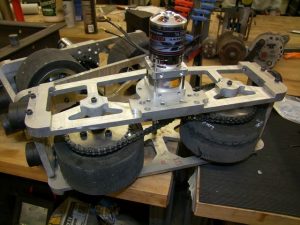
If you want something spinning hard and fast, brushless is where it’s at. Brushless motors offer much better power-to-weight ratios compared to brushed DC motors, but some applications – like a large robot’s drivetrain – are less straightforward than others. One of the biggest issues is control. Inexpensive brushless motors are promising, but as professor churlz puts it, “hobby motor control equipment is not well suited for the task. Usually created for model air planes, the controllers are lightly built, rated to an inch of the components’ lives using unrealistic methods, and usually do not feature reversing or the ability to maintain torque at low speeds and near-stall conditions, which is where DC motors shine.” Taking into account the inertia of a 243 lb robot is a factor as well – the controller and motor want to start moving immediately, but the heavy robot on the other side of it doesn’t. The answer was a mixture of hardware and firmware tweaking with a lot of testing.
The build log is full of interesting things including gearing and other mechanical details of the robot, but to get the gist of the brushless motor drive train journey there is the section on what led professor churlz to think about whether brushless motors – varyingly successful in little bots – would scale up to a ~250lb robot, details about his testing and investigation of the motors and controllers he chose, and finally a summary of his conclusions. In the end he found it a qualified success.